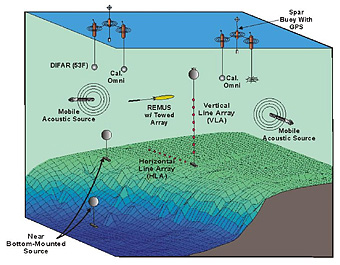Autonomous Wide Aperture Cluster for Surveillance (AWACS) - MSEAS Home Page
AWACS PIs:
P. Abbot, B. Carey, C.-S. Chiu, G. Gawarkiewicz,
J. Krolik, P.F.J. Lermusiaux, J. Lynch, S. Smith.
Collaborators: T. Duda, K.D. Heaney
Ongoing MIT-MSEAS Research
Return to top of document
Additional AWACS Links
Return to top of document
Presentations
- MIT AWACS Research Goals, Objectives and Results - presented at 12 Sept. 2007 AWACS meeting
[Powerpoint]
[PDF]
Return to top of document
Background information
Goal: Improve modeling of ocean dynamics, and develop and evaluate new adaptive sampling
and search methodologies, for the environments in which the main AWACS-06, -07 and -09
experiments will occur, using the re-configurable REMUS cluster and coupled data assimilation
Specific objectives are to:
- Evaluate current methods and develop new algorithms for adaptive environmental-acoustical
sampling, search and coupled DA techniques (Stage 1), based on a re-configurable REMUS
cluster and on idealized and realistic simulations (with NPS/OASIS/Duke)
- Research optimal REMUS configurations for the sampling of interactions of the oceanic
mesoscale with inertial oscillations, internal tides and boundary layers (with
WHOI/NPS/OASIS)
- Develop new adaptive ocean model parameterizations for specific AWACS-06, -07 and -09
processes, and compare these regional dynamics (with WHOI)
- Provide near real-time fields and uncertainties in AWACS-06, -07 and -09 experiments and,
in the final 2 years, develop algorithms for fully-coupled physical-acoustical DA among
relocatable nested 3D physical and 2D acoustical domains
- Provide adaptive sampling guidance for array performance and surveillance (Stage 2), and
link HU research with vehicle models and command and control.
Return to the MSEAS home page
Accessibility

